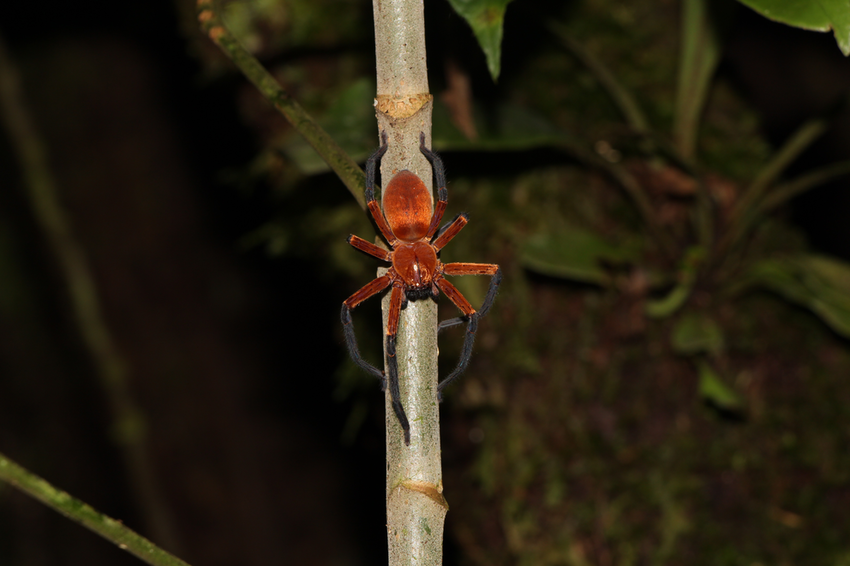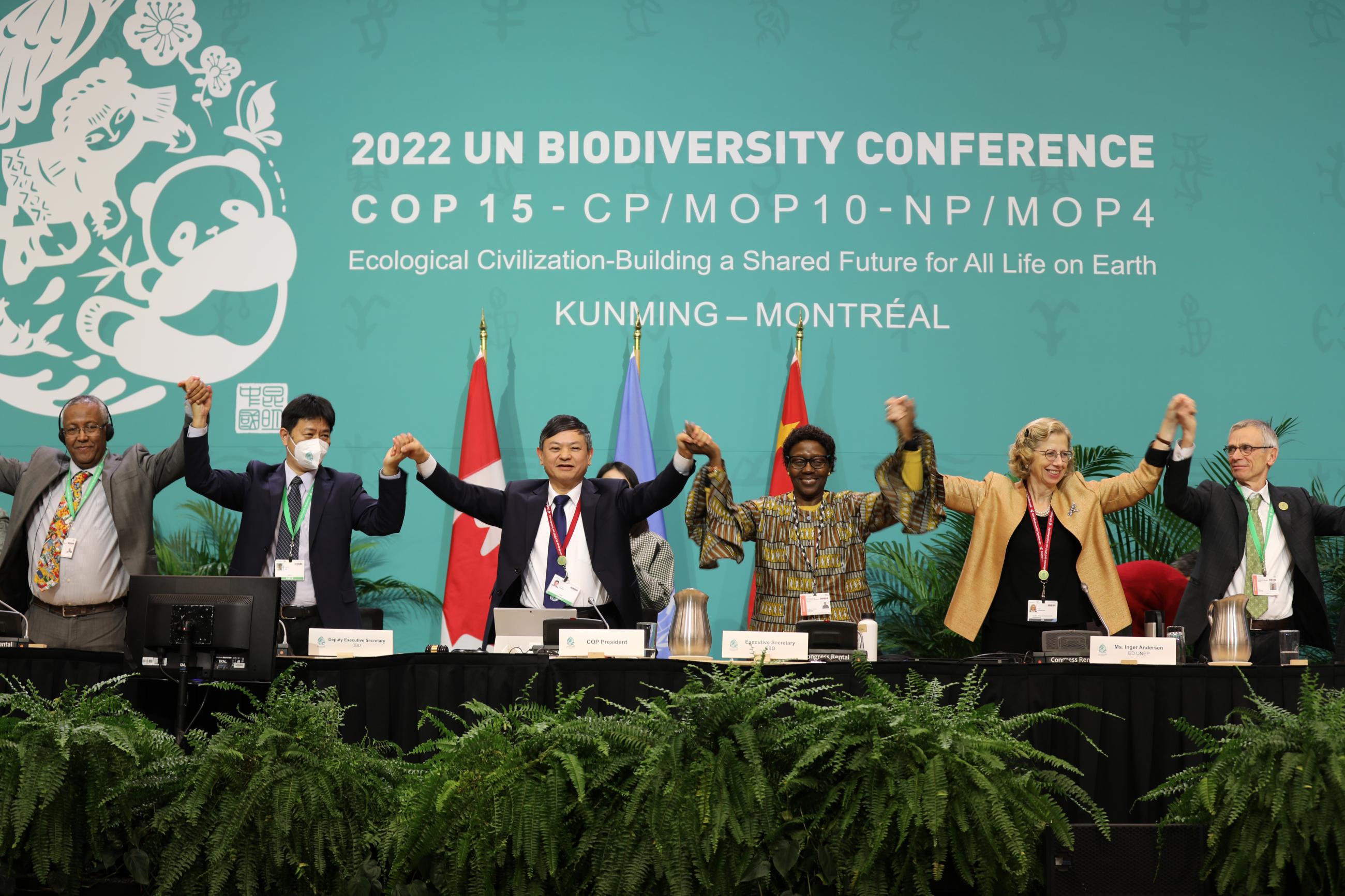UN Biodiversity Conference
8 October 2024
“Biodiversity is fundamental to human well-being, a healthy planet, and economic prosperity for all people, including for living well in balance and in harmony with Mother Earth. We depend on it for food, medicine, energy, clean air and water, security from natural disasters as well as recreation and cultural inspiration, and it supports all systems of life on Earth.”
This statement opens the 2022 Kunming-Montreal Global Biodiversity Framework (GBF), which was adopted in 2022 by the fifteenth meeting of the Conference of the Parties (COP) to the Convention on Biological Diversity (CBD). Now, two years later, governments and other stakeholders are convening at the 2024 UN Biodiversity Conference to take the next steps toward enhancing global biodiversity policy and reversing the disturbing trend of biodiversity loss.
What is Biodiversity?
Biological diversity is most often associated with the Earth’s vast variety of plants, animals, and microorganisms, but the term encompasses diversity at all levels, from genes to species to ecosystems to landscapes. Scientists estimate there are approximately 8.7 million species globally, of which approximately 2.2 million are marine. Despite hundreds of years of research and over 1.2 million species already identified, it is possible 86% of existing species on Earth and 91% of species in the ocean still await description.
Ecosystems are another aspect of biodiversity. In each ecosystem—including those that occur within or among forests, wetlands, mountains, deserts, and rivers—living creatures interact with each other as well as with the air, water, and soil around them. In this way, they form an interconnected community. Biodiversity also includes genetic differences within species, such as different breeds and varieties, as well as chromosomes, genes, and genetic sequences (DNA).

The Global Assessment Report on Biodiversity and Ecosystem Services, which was approved by the Intergovernmental Science-Policy Platform on Biodiversity and Ecosystem Services (IPBES) in May 2019, concluded that human actions now threaten more species with global extinction than ever before. The current rate of species extinction is tens to hundreds of times higher than it has averaged over the past 10 million years. An average of around 25% of species in assessed animal and plant groups are threatened, suggesting that around 1 million species already face extinction, many within decades, unless action is taken to reduce the intensity of drivers of biodiversity loss. Without such action, the rate of species extinction will accelerate even more.
Furthermore, IPBES points out that biodiversity loss is caused by both direct and indirect drivers. Direct drivers include climate change, pollution, land use change, invasive alien species, and zoonotic disease. Key indirect drivers of biodiversity include increased population and per capita consumption; technological innovation, which in some cases has lowered and in other cases increased the damage to nature; and, critically, issues of governance and accountability.
What is the Convention on Biological Diversity?
In 1987, concern about the rate of species extinction led the United Nations Environment Programme (UNEP) to create a working group of experts to study the potential for an umbrella convention to address biodiversity conservation. As the group began its substantive work in 1990, the idea of a biodiversity convention became entangled in disputes concerning the ownership of genetic resources. Developing countries called for explicit recognition of national sovereignty over genetic resources because application of intellectual property rights had reversed the previous treatment of genetic resources as public goods. Some developing countries insisted that genetic resources belong to the states in which they are located, and that access should be based on a “mutual agreement between countries.” They also argued for the inclusion of provisions for non-commercial access to biotechnologies based on plant genetic resources found in the South as a central element in any biodiversity convention. Some industrialized countries expressed concerns about companies’ intellectual property rights, and many also initially opposed the inclusion of biotechnology in the convention.
Formal negotiations on what would become the CBD were completed in May 1992. One hundred fifty-three countries signed the convention at the Earth Summit in Rio de Janeiro, Brazil, in June 1992, and the CBD entered into force on December 29, 1993. One hundred ninety-six countries are now parties, with the notable exception of the United States.
The CBD has three objectives: conservation of biological diversity, sustainable use of its components, and fair and equitable sharing of benefits arising out of the use of genetic resources. Among its wide-ranging provisions, parties are expected to inventory and monitor biodiversity, incorporate the concepts of conservation and sustainable use into national strategies and economic development, and preserve Indigenous conservation practices. The fact that the treaty encompasses socioeconomic issues, such as the sharing of benefits from the use of genetic resources and access to technology, including biotechnology, necessitated additional guidance. As a result, the Conference of the Parties (COP) called for two protocols: the first to establish concrete commitments on biosafety, and the second on the sharing of benefits from the use of genetic resources.
Cartagena Protocol on Biosafety: Under the CBD, biosafety refers to precautionary practices that seek to ensure the safe transfer, handling, use, and disposal of living modified organisms (LMOs) derived from modern biotechnology. By the early 1990s, most countries with biotechnology industries had domestic biosafety legislation in place, but there were no binding international agreements regarding genetically modified organisms that cross national borders.
Parties to the CBD began to address this issue in 1996 and completed the negotiations on the Cartagena Protocol on Biosafety in 2000. The Protocol, which entered into force in September 2003, requires parties to take precautionary measures to prevent LMOs from causing harm to biodiversity and human health. The Cartagena Protocol established the first international agreement requiring countries to take measures to prevent LMOs from causing harm to biodiversity and human health.
At its fifth meeting of the parties (MOP) to the Cartagena Protocol in 2010 a new phase in the international regulation of biotechnology began with the adoption of the Nagoya–Kuala Lumpur Supplementary Protocol on Liability and Redress to the Cartagena Protocol. The Supplementary Protocol aims to contribute to the conservation and sustainable use of biodiversity by providing international rules and procedures on liability and redress for damage to biodiversity resulting from LMOs.
Nagoya Protocol on Access and Benefit-sharing: Genetic resources from plants, animals, and microorganisms are used for a variety of purposes, ranging from basic research to consumer products to medicines. Those using genetic resources include research institutes, universities, and private companies operating in many different economic sectors, including pharmaceuticals, agriculture, horticulture, cosmetics, material science, and biotechnology.
The CBD’s third objective—fair and equitable sharing of benefits arising from the use of genetic resources—involves how companies, collectors, researchers, and others gain access to valuable genetic resources in return for sharing the benefits of this access with the countries of origin and local communities and Indigenous Peoples. In 2004, the COP created a Working Group on Access and Benefit Sharing to elaborate a protocol to address these issues.
After six years of often difficult negotiations, parties adopted the Nagoya Protocol on Access to Genetic Resources and the Fair and Equitable Sharing of Benefits Arising from Their Utilization in October 2010. The Protocol provides a basis for greater legal certainty and transparency for providers and users of genetic resources. Parties have specific obligations to develop domestic legislation or regulatory requirements for the party providing genetic resources. Compliance provisions, as well as provisions establishing more predictable conditions for access to genetic resources, contribute to ensuring benefit sharing with the party providing the genetic resources in question. In addition, the Protocol contains provisions on access to traditional knowledge held by Indigenous Peoples and local communities when it is associated with genetic resources. The Nagoya Protocol entered into force in October 2014.

The Kunming-Montreal Global Biodiversity Framework
The Kunming-Montreal Global Biodiversity Framework (GBF) was adopted by the fifteenth meeting of the Conference of the Parties (COP 15) in Montreal, Canada, in December 2022 after a four-year consultation and negotiation process that was disrupted by the COVID-19 pandemic. The GBF builds upon the 2011-2020 Strategic Plan for Biodiversity, including the Aichi Biodiversity Targets. The Framework supports the achievement of the Sustainable Development Goals and sets out an ambitious pathway to reach the global vision of a world living in harmony with nature by 2050. Among the Framework’s key elements are four overarching goals for 2050:
- halting human-induced extinction of threatened species and reducing the rate of extinction of all species tenfold by 2050;
- sustainable use and management of biodiversity to ensure that nature’s contributions to people are valued, maintained and enhanced;
- fair sharing of the benefits from the utilization of genetic resources, and digital sequence information (DSI) on genetic resources; and
- adequate means of implementing the GBF be accessible to all parties, particularly least developed countries and small island developing states.
The GBF also has 23 targets to be achieved by 2030 (See Box 1)
| Box 1: Kunming-Montreal Global Biodiversity Framework Targets |
|---|
| 1. Plan and Manage all Areas to Reduce Biodiversity Loss |
| 2. Restore 30% of all Degraded Ecosystems |
| 3. Conserve 30% of Land, Waters and Seas |
| 4. Halt Species Extinction, Protect Genetic Diversity, and Manage Human-Wildlife Conflicts |
| 5. Ensure Sustainable, Safe and Legal Harvesting and Trade of Wild Species |
| 6. Reduce the Introduction of Invasive Alien Species by 50% and Minimize Their Impact |
| 7. Reduce Pollution to Levels That Are Not Harmful to Biodiversity |
| 8. Minimize the Impacts of Climate Change on Biodiversity and Build Resilience |
| 9. Manage Wild Species Sustainably to Benefit People |
| 10. Enhance Biodiversity and Sustainability in Agriculture, Aquaculture, Fisheries, and Forestry |
| 11. Restore, Maintain and Enhance Nature’s Contributions to People |
| 12. Enhance Green Spaces and Urban Planning for Human Well-Being and Biodiversity |
| 13. Increase the Sharing of Benefits from Genetic Resources, Digital Sequence Information and Traditional Knowledge |
| 14. Integrate Biodiversity in Decision-Making at Every Level |
| 15. Businesses Assess, Disclose and Reduce Biodiversity-Related Risks and Negative Impacts |
| 16. Enable Sustainable Consumption Choices to Reduce Waste and Overconsumption |
| 17. Strengthen Biosafety and Distribute the Benefits of Biotechnology |
| 18. Reduce Harmful Incentives by at Least $500 Billion per Year, and Scale Up Positive Incentives for Biodiversity |
| 19. Mobilize $200 Billion per Year for Biodiversity From all Sources, Including $30 Billion Through International Finance |
| 20. Strengthen Capacity-Building, Technology Transfer, and Scientific and Technical Cooperation for Biodiversity |
| 21. Ensure That Knowledge Is Available and Accessible to Guide Biodiversity Action |
| 22. Ensure Participation in Decision-Making and Access to Justice and Information Related to Biodiversity for all |
| 23. Ensure Gender Equality and a Gender-Responsive Approach for Biodiversity Action |
Although it is not legally binding, the GBF gives countries a set of markers to guide action equal to their ambition, from targets for protecting and restoring ecosystems to halting the loss of species and working with a human-rights based approach. To be successful, governments must translate the GBF into national actions for implementation on the ground. Thus, CBD parties committed to setting national implementation targets and all other actors have been invited to develop and communicate their own commitments.
To date, over 100 parties have submitted at least one national target and 57 of them have submitted national targets for every GBF target. While most countries are focusing on the submission of national targets, 35 parties have already submitted National Biodiversity Strategies and Action Plans (NBSAPs) aligned with the global aims of the GBF: Burkina Faso, Malaysia, Suriname, Italy, Canada, Uganda, Austria, Ireland, China, the European Union, France, Hungary, Ireland, Japan, Luxembourg and Spain.
What’s Next?
The 2024 UN Biodiversity Conference convenes for the first time since the adoption of the GBF in Cali, Colombia, from 21 October - 1 November 2024. The Conference includes the sixteenth meeting of the CBD COP, the eleventh meeting of the COP serving as the meeting of the parties to the Cartagena Protocol, and the fifth meeting of the COP serving as the meeting of the parties to the Nagoya Protocol.
Parties will review the state of implementation of the GBF and show how they have aligned their NBSAPs with the Framework. COP 16 will further develop the monitoring framework and advance resource mobilization. Parties will also take stock of the national targets and commitments that have been announced.
Among other tasks, COP 16 is expected to finalize and operationalize the multilateral mechanism on the fair and equitable sharing of benefits from the use of digital sequence information (DSI) on genetic resources. As biodiversity-based research and development becomes increasingly based on the information content of genetic resources, enabled by genomic technologies, the physical access to biological samples of genetic resources may become unnecessary, and fair and equitable benefit-sharing harder to achieve. If open access to DSI is not accompanied by benefit-sharing modalities, the CBD’s third objective will become increasingly out of reach and the Nagoya Protocol could become irrelevant.
At COP15, parties established a working group (Decision 15/9) on DSI on genetic resources to discuss how to operationalize a multilateral mechanism for benefit-sharing from the use of DSI on genetic resources, including a global fund, as part of the GBF and make recommendations to COP16. The outcome of the Working Group, which met twice in 2023 and 2024, is a draft recommendation, including lists of options for: the basis and modalities of monetary contributions by DSI users to the global fund; the methodology and criteria for funding allocation; and data governance, including the mechanism’s relationship with public DSI databases. Other outstanding issues revolve around: the mechanism’s relationship with national access and benefit-sharing measures on DSI; its positioning regarding relevant international instruments, such as the International Treaty on Plant Genetic Resources for Food and Agriculture (ITPGRFA); and the legal obligations parties will accept to enforce to users and databases within their jurisdiction.

The COP will also address a new programme of work on Indigenous Peoples and local communities (IPLCs), among related issues emanating from the Working Group on Article 8(j). The Convention recognizes the dependency of IPLCs on biodiversity and their unique role in conserving life on Earth. Under Article 8(j) of the Convention, each party has undertaken to:
“subject to its national legislation, respect, preserve and maintain knowledge, innovations, and practices of Indigenous and local communities embodying traditional lifestyles relevant for the conservation and sustainable use of biological diversity, and promote their wider application with the approval and involvement of the holders of such knowledge, innovations, and practices and encourage the equitable sharing of the benefits arising from the utilization of such knowledge, innovations, and practices.”
The last meeting of the Working Group on Article 8(j) proved challenging, particularly around terminology issues. Springing from a recommendation by the UN Permanent Forum on Indigenous Issues (UNPFII) to distinguish between Indigenous Peoples and local communities, delegates engaged in a difficult discussion on the issue, revealing fundamentally different opinions. Some underscored the years-long struggles of Indigenous Peoples for the recognition of their rights, lamenting that some states have denominated Indigenous Peoples as local communities to reduce those rights. Others highlighted the centuries-old role local communities have played, and will continue to play, in preserving biological resources and transmitting knowledge, stressing while Indigenous Peoples and local communities may be “different entities,” separating them is out of the question.
While issues around IPLC terminology constitute a Gordian knot and may only be resolved in the long-term via genuine dialogue among and between Indigenous Peoples and local communities, a major concern is that these disagreements spilled over into other agenda items, slowing down the development of a new programme of work, which will have to be concluded at COP 16.
The decisions expected to be adopted at the 2024 UN Biodiversity Conference are essential for implementation of the GBF, the Convention and the Protocols. Negotiations are not going to be easy, but most participants recognize that unless biodiversity loss is stemmed, all life on Earth hangs in the balance.
Pamela Chasek, Ph.D., is the Co-founder and Executive Editor of the Earth Negotiations Bulletin.